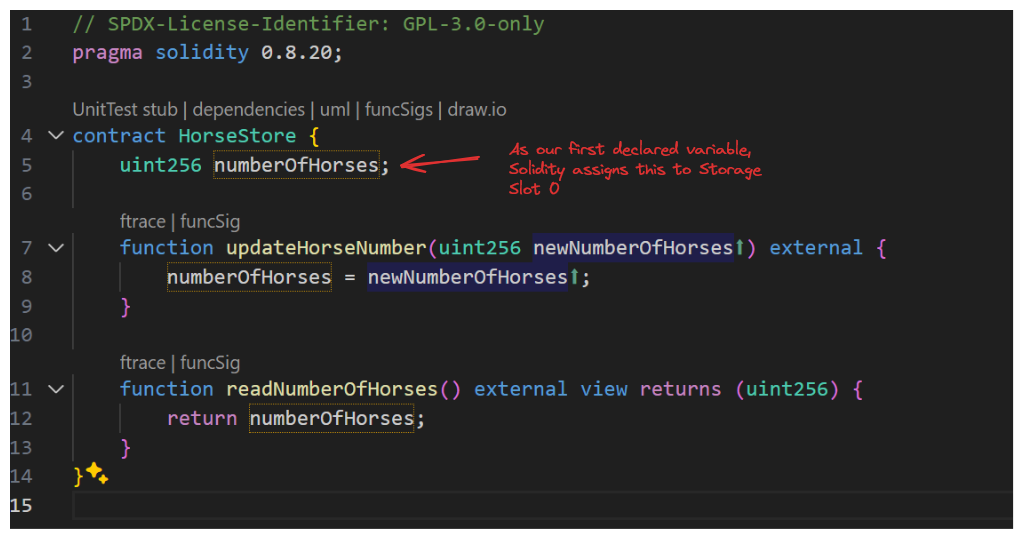5/5
_Follow along with this video:_ --- ### Assigning Storage Slots Our numberOfHorses variable requires a storage slot, and there's a number of ways we could approach this. We could absolutely hardcode a storage slot for example. Fortunately, Huff makes working with storage slots a little bit easier through a convenient abstraction: `FREE_STORAGE_POINTER()`. `FREE_STORAGE_POINTER()` effectively works as a counter for available storage slots. Let's add this to our code base. ```js /*Interface*/ #define function updateHorseNumber(uint256) nonpayable returns() #define function readNumberOfHorses() view returns(uint256) #define constant NUMBER_OF_HORSES_STORAGE_SLOT = FREE_STORAGE_POINTER() #define macro MAIN() = takes(0) returns(0){ 0x00 calldataload 0xe0 shr // [function_selector] // updateHorseNumber, 0xcdfead2e dup1 __FUNC_SIG(updateHorseNumber) eq updateJump jumpi // [function_selector] // readNumberOfHorses, 0xe026c017 __FUNC_SIG(readNumberOfHorses) eq readJump jumpi // [] 0x00 0x00 revert updateJump: SET_NUMBER_OF_HORSES() readJump: GET_NUMBER_OF_HORSES() } #define macro SET_NUMBER_OF_HORSES() = takes(0) returns(0){} #define macro GET_NUMBER_OF_HORSES() = takes(0) returns(0){} ``` What the line `#define constant NUMBER_OF_HORSES_STORAGE_SLOT = FREE_STORAGE_POINTER()` is doing is defining a particular storage slot to be used for this constant variable. `FREE_STORAGE_POINTER()` will return the next sequentially available storage slot, assigning our constant, in this case, to 0. The next time `FREE_STORAGE_POINTER()` is called it will assign 1. This is exactly how Solidity handles things as well!  With our above implementation, any time somebody looks at storage slot 0, that's where numberOfHorses will be found. Great work!
Follow along with this video:
Assigning Storage Slots
Our numberOfHorses variable requires a storage slot, and there's a number of ways we could approach this. We could absolutely hardcode a storage slot for example.
Fortunately, Huff makes working with storage slots a little bit easier through a convenient abstraction: FREE_STORAGE_POINTER(). FREE_STORAGE_POINTER() effectively works as a counter for available storage slots. Let's add this to our code base.
What the line #define constant NUMBER_OF_HORSES_STORAGE_SLOT = FREE_STORAGE_POINTER() is doing is defining a particular storage slot to be used for this constant variable. FREE_STORAGE_POINTER() will return the next sequentially available storage slot, assigning our constant, in this case, to 0. The next time FREE_STORAGE_POINTER() is called it will assign 1.
This is exactly how Solidity handles things as well!

With our above implementation, any time somebody looks at storage slot 0, that's where numberOfHorses will be found. Great work!
FREE_STORAGE_POINTER()
A beginner’s guide to working with storage slots in Huff - This lesson covers how storage slots work in Huff, and how they relate to Solidity. It introduces the keyword `FREE_STORAGE_POINTER`, which helps manage storage slots in a more concise way. The lesson also shows a simple implementation of a storage variable in Huff, and explains how to use it to store the number of horses in a smart contract.
Previous lesson
Previous
Next lesson
Next
Give us feedback
Course Overview
About the course
What you'll learn
Assembly
Writing smart contracts using Huff and Yul
Ethereum Virtual Machine OPCodes
Formal verification testing
Smart contract invariant testing
Halmos, Certora, Kontrol
Course Description
Who is this course for?
- Smart contract security researchers
- Advanced Smart contract engineers
- Chief Security Officiers
- Security professionals
Potential Careers
Security researcher
$49,999 - $120,000 (avg. salary)
Smart Contract Auditor
$100,000 - $200,000 (avg. salary)
Meet your instructors
Guest lecturers:
Last updated on August 11, 2025
Duration: 30min
Duration: 4h 38min
Duration: 3h 57min
Duration: 1h 56min
Course Overview
About the course
What you'll learn
Assembly
Writing smart contracts using Huff and Yul
Ethereum Virtual Machine OPCodes
Formal verification testing
Smart contract invariant testing
Halmos, Certora, Kontrol
Course Description
Who is this course for?
- Smart contract security researchers
- Advanced Smart contract engineers
- Chief Security Officiers
- Security professionals
Potential Careers
Security researcher
$49,999 - $120,000 (avg. salary)
Smart Contract Auditor
$100,000 - $200,000 (avg. salary)
Meet your instructors
Guest lecturers:
Last updated on August 11, 2025
